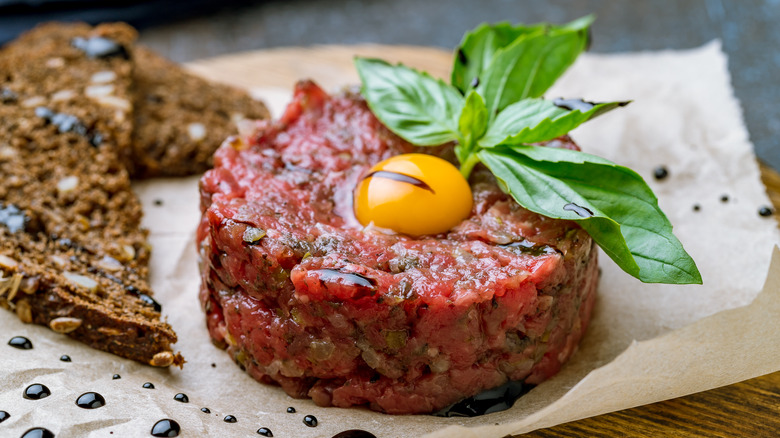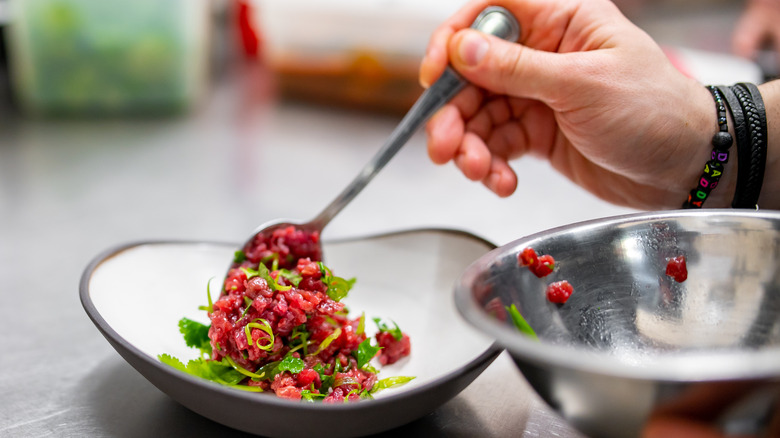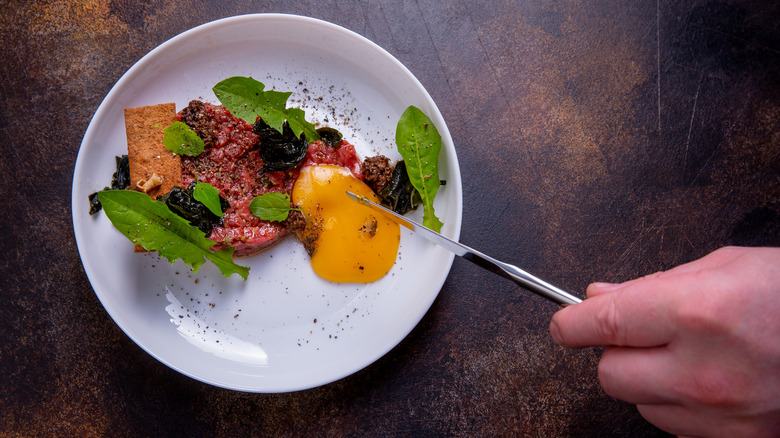How Steak Tartare Became A Restaurant Menu Staple
In recent years, steak tartare, sometimes called "beef tartare", has been having a prolonged moment in the spotlight. Since roughly the mid-2010s, it seems near-impossible to visit any trendy restaurant without stumbling onto this 19th-century French dish of seasoned raw beef. Its popularity is surprising considering the tendency for Americans to be more squeamish eaters, who might not instinctually gravitate towards a plate of raw meat, often garnished with a raw egg yolk on top.
Yet, the steak tartare wave hit American restaurants hard and arguably has yet to crash. There seem to be two notable reasons why restaurants clamored to put it on their menu — aside from the fact that at least some establishments were likely just following the crowd. Firstly, it's a dish that allows chefs to get creative since the raw beef is a great base for adding additional flavors. Secondly, it may also be an economical dish that allows restaurants to not waste meat, at least in certain cases, but more on that in a moment.
How steak tartare lets chefs get creative
Think about the myriad ways that beef is flavored and seasoned in all sorts of other dishes, from a peppery sauce for steak to a chili-laden Chinese-style stir-fry. While it's not a neutral base (compared to something like pasta), it plays well with a lot of flavors. And that means it's a dish that chefs can get playful with. Sure, in a French brasserie, the kitchen would probably be expected to do a classic version of the dish, with shallots, cornichons, Dijon mustard, a little vinegar, and an egg yolk on top.
But if you're not bound by those expectations, then the sky's the limit. You can infuse that beef with Vietnamese flavors like fish sauce, chili, and cilantro, or bring in unusual accouterments like oysters and geoduck, as chef Mathieu Escoffier (of the one Michelin-starred Ma's Cuisine) does, according to Michelin. Wasabi and sesame with a quail egg yolk? Sure, that could work too. In short, if you're a chef who's looking to impress people with an out-of-the-box recipe, an unexpected version of steak tartare is a great place to start.
It may also be economical in some cases
For certain restaurants, serving a tartare is a smart way to avoid food waste, by helping to use up extra pieces of beef that may not be big enough to repurpose elsewhere on the menu. There are a few caveats here, though.
This isn't to say that restaurants can cheap out on buying random meat scraps and use them for tartare — since the dish is raw meat, you want to be sourcing your meat from reliable and responsible sources where the chances of cross-contamination are minimal. Similarly, if you're using beef offcuts, it still needs to be fresh, for the sake of both safety and taste. This may often apply in the case of steakhouses, where steaks will be cut to a certain weight, so there may be small cuts of quality beef floating around that can't be used cohesively in other dishes, although you may not want to mix up from different sources, just to be safe. But, if a restaurant is cutting their steaks and immediately repurposing the additional meat, that could be a wise idea.
If you're visiting well-regarded establishments, you probably don't have much to worry about. Ultimately, a well-managed restaurant won't sacrifice taste or safety to save a few bucks or for the opportunity to get a bit creative.


